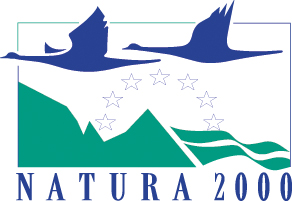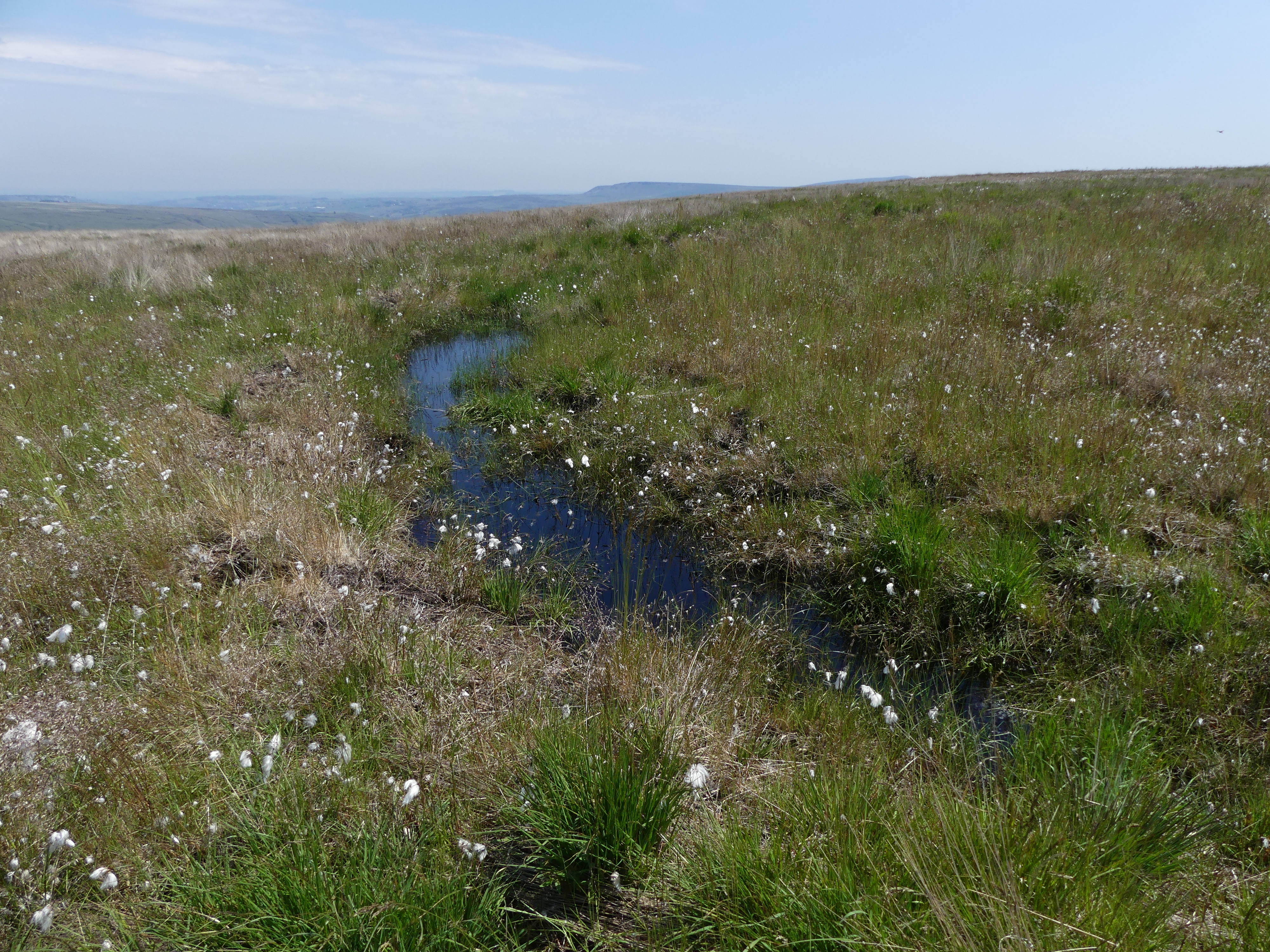We are pioneering and testing a new technique to improve the condition of blanket bog habitat.
The aim of the trial is to discover if constructing bunds can improve the health of blanket bogs, returning them to the healthiest condition a bog can be in (known as ‘state 6’ active blanket bog). Find out more about states of blanket bog.
The bunds have been designed to slow the flow of water from the hills. They are long, low mounds, which retain water in shallow pools behind them, causing the water to released at a slower rate.
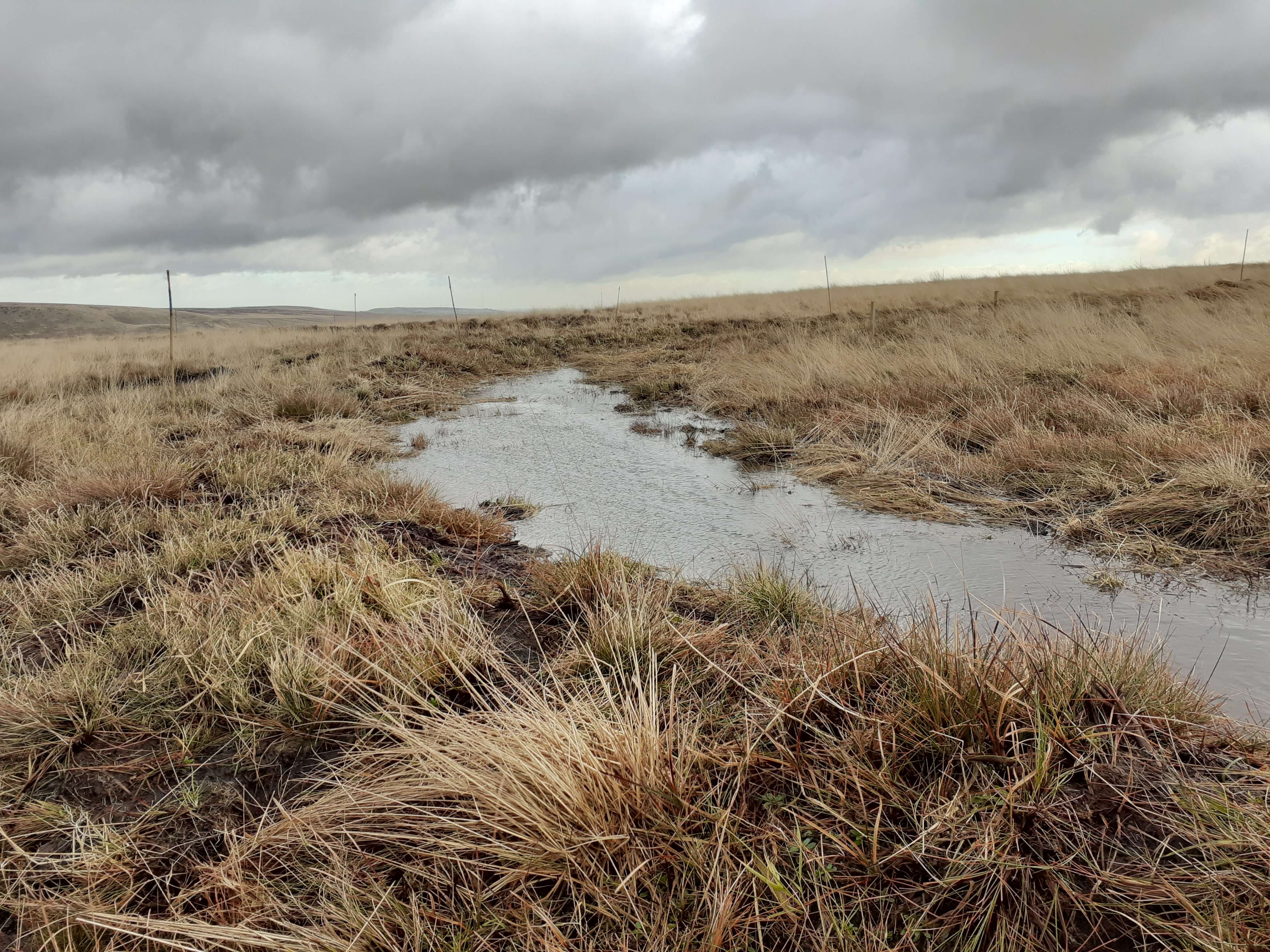
Bunds are designed to address the less visible but nonetheless critical damage our blanket peat is facing today. Healthy bogs are very wet. Bunds are specifically designed to hold water for longer so that the peat stays wetter. This encourages those plants which favour the wetter, boggier ground, and define our boggy ecosystems: plants such as sphagnum mosses, cotton grasses, cross-leaved heath, cranberry and possibly even sundews and bog rosemary. In turn, we expect this to increase the help nature gives back to us, by storing more carbon and securing our water supplies.
We have constructed the bunds on the flatter areas at the tops of the hills, where slope angles are 5 degrees or less. This is also where the deepest peat is found. Where slopes are shallow, water backing up behind a bund covers a greater area. This results in more area of peat being kept wetter for longer.
Where using the technique of creating bunds is judged to be appropriate, safe and practical, they are constructed at the top of the hill regardless of where the more visible scars like bare peat pans or gullies are. Conversely, peat, stone and other types of dam are specifically put into eroded features like gullies as a specific remedy, alongside other rewetting and revegetation techniques.
Bunding is one of many techniques used in combination, as a whole package of care, to address struggling blanket peat habitats.
What we're measuring
Sphagnum moss has been planted behind and on the bunds. The trial will measure how well the sphagnum grows. Sphagnum thrives in wetter areas, so the bunds are expected to improve the survival and growth of this key bog-building moss.
It is hoped that this will result in multiple benefits to society and wildlife.
The trial is designed to measure the impact of the bunds in the following ways:
2x2m vegetation quadrats set up behind the bunds will be used to monitor the impact on vegetation, including Molinia (purple moor grass), sphagnum and other species.
Automated and manual dipwells will monitor water table height (how close the water is to the surface of the ground).
Peat anchors will monitor sediment accumulation (whether peat is being trapped behind the bunds, rather than being washed away into rivers and reservoirs).
Manual measurements of the water retained behind the bund to monitor how much water is temporarily retained after a rain event.
The bunds were constructed in February 2020 and it is hoped that within a year we will be able to see results from the hydrology data (dipwells). Other outcomes will take longer to become clear, and the Partnership will be undertaking long-term monitoring of the site.
The trial is being carried out in partnership with the National Trust on their Marsden Moor estate, as part of the MoorLIFE 2020 project.
The trial includes three different layout designs plus a control site where no work has been done. Each of the four sites contains three experimental quadrats where we are collecting data about water table, peat depth and vegetation.
The layout designs are scallop, semi-circular 'fish scale' and contour. The trial aims to assess how bunds affect the variables compared to doing nothing, and how the designs compare to one another in terms of the desired outcomes of a wetter moor with more diverse vegetation and better water storage capacity.
We hope the data will yield evidence about how best to apply this new technique across the diverse upland landscape.
This diagram shows the designs:
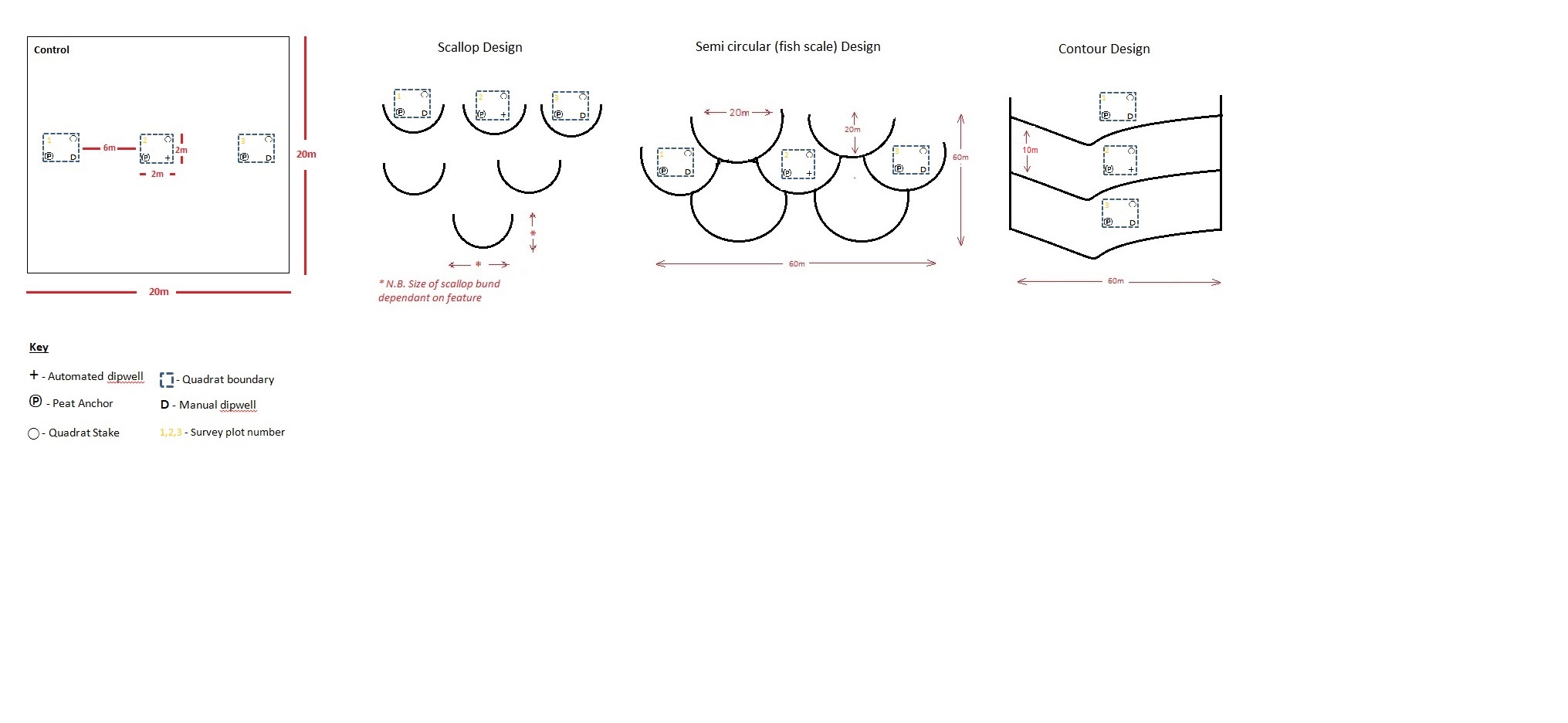
Project update - preliminary results
Update November 2020
The bunds are holding water in the environment – we have been able to confirm this from visual records and from manual measurements of water taken from behind the bunds. On average, the bunds are holding 144mm of water, with the deepest water measured at 300mm.
This water is being held behind the bund for at least 12 hours after rain has fallen. This means that during a high rainfall event, water is being held on the moor, slowing the flow of water from the hills, and preventing that water from arriving in the valleys below all at once. At scale, this may help reduce flood risk and lower flood waters.
We’re analysing the data from the automated water table loggers to find what impact the bunds are having on the water table. This analysis is still being undertaken, once complete the results will be shared on this page.
It’s too early to report on the impact the bunds have had on the growth of molinia (purple moor grass (which we’re hoping it will become less dominant), sphagnum moss (which we’re hoping will thrive in the new, wetter environment), and other species. Monitoring the sediment accumulation will also take time to show results.
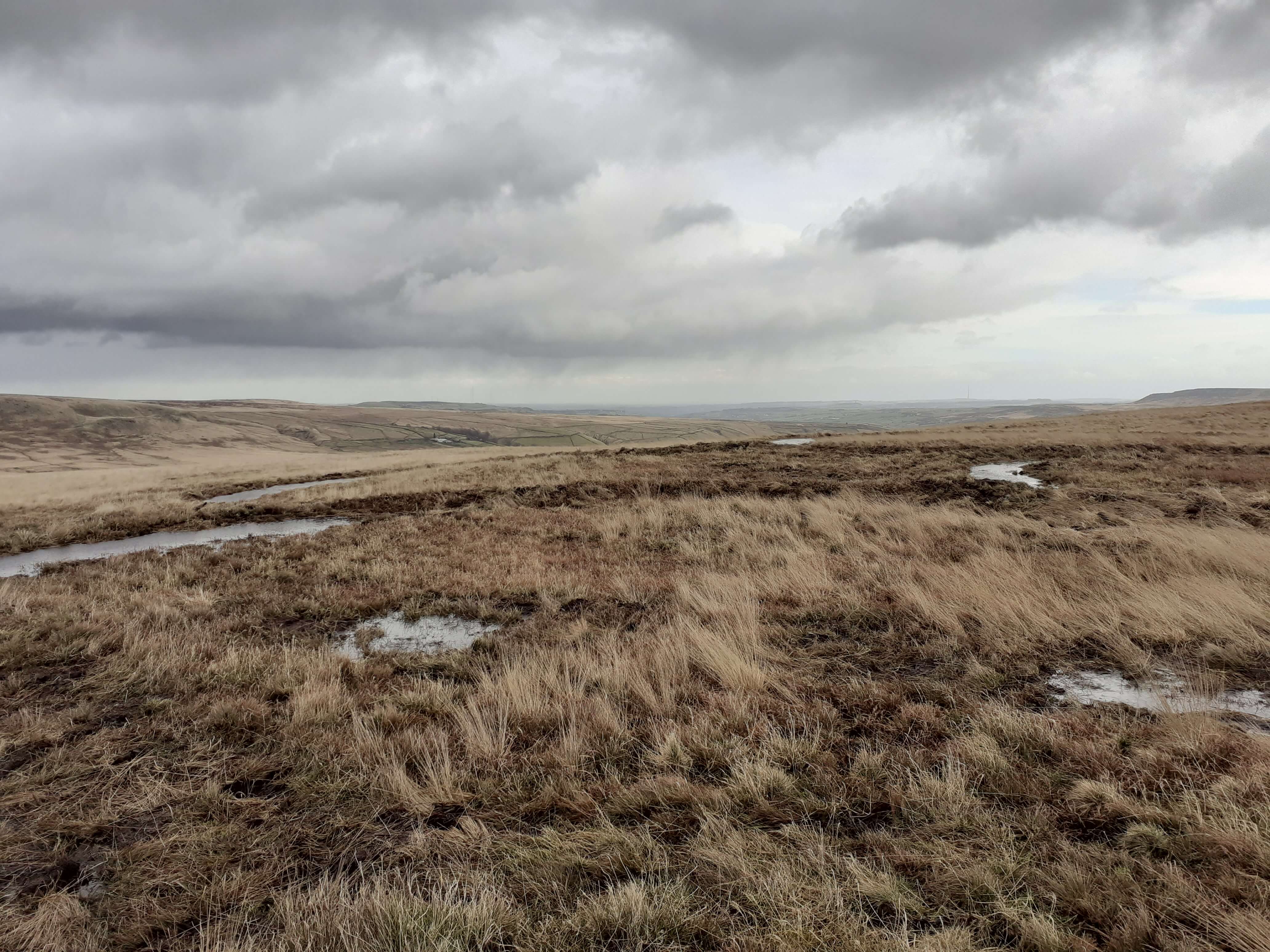
Update June 2022
The preliminary results from this trail currently show that:
All the bund types have increased the height of the water table during the wetter months. The fluctuations in water table depth over the course of the study (18 Feb 2020-31 Oct 2021) vary, with contour bunds increasing the water height of the water table most, and most consistently.
Contour bunds (60m long thin mounds of peat but only 200mm high)
On average, contour bunds have shown a year on year decrease in Molinia, when compared to the control.
Scallop bunds (individual horseshoe shaped mounds of peat, approximately 200mm high)
On one site, scallop bunds have also shown a decrease in average Molinia (purple moor grass) cover relative to control, but this has not been replicated on another site.
Fishscale bunds (interconnected horseshoe shaped mounds of peat)
Fishscale bunds have not shown an average decrease in Molinia, compared to the control.
Funded by

